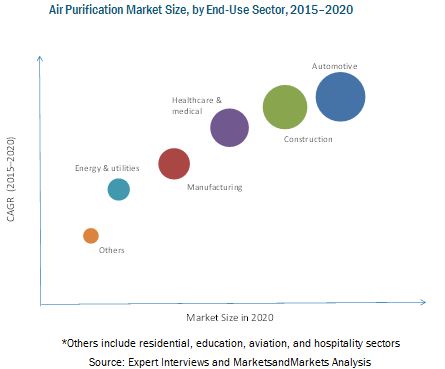Browse more than 191 market data tables with 51 figures spread through 205 Pages and in-depth TOC on "Air Purification Systems Market"
Ask for Sample Pages @
https://www.marketsandmarkets.com/requestsampleNew.asp?id=12496591
Accelerated urbanization, growth in infrastructural activities, and increasing industrialization has multiplied the rate of air pollution in the environment which has resulted in the need for air purification systems across the globe. The increasing income and spending capacity of people in developing economies and increasing demand in various end-use sectors such as automotive, building & construction, healthcare & medical, manufacturing, and energy & utilities are the major factors driving the growth of the air purification market. The strict regulations pertaining to industrial emissions and concern about occupational health and safety of the workers have led the industrial and commercial sector bodies to look into the concern of air purification needs at all their operating facilities.
Dust Collector segment to gain maximum traction during the forecast period
Dust collectors are used to improve the quality of air discharged from commercial and industrial processes through collecting dust, impurities, and other allergen particles from air or gas. A dust collector system generally consists of a blower, dust filter, filter cleaning system, and a dust removal system. It removes solid granule pollutants from exhaust gases before venting to the outer atmosphere and also recovers valuable solid or powder granules from process streams. The demand for this type of air purification system holds a significant part of the air purification market. The reason behind the growth of this product segment is the need of making the ambient and in-door air dust-free, which is the primary concern of the population and government in this industrial era.
Early buyers will receive 10% customization on reports.
Asia-Pacific to play a key role in the air purification market
Factors such as the increasing urbanized population in China and India along with the growth in disposable income, and the growing concern regarding the ill-effects of air pollution on human health in these countries are driving the growth of the Asia-Pacific air purification market. Rapid industrialization and imposition of strict laws pertaining to toxic emission control are also major factors contributing to the growth of the air purification market in this region.

- Honeywell International Inc. (U.S.)
- 3M Company (U.S.)
- Sharp Corporation (Japan)
- Daikin Industries, Ltd. (Japan)
- Air Products and Chemicals, Inc. (U.S.)
- Clean TeQ Holdings Limited (Australia)
- Alfa Laval AB (Sweden)
- SPX Corporation (U.S.)
- Mann+Hummel GmbH (Germany)
- Clarcor Inc. (U.S.)








